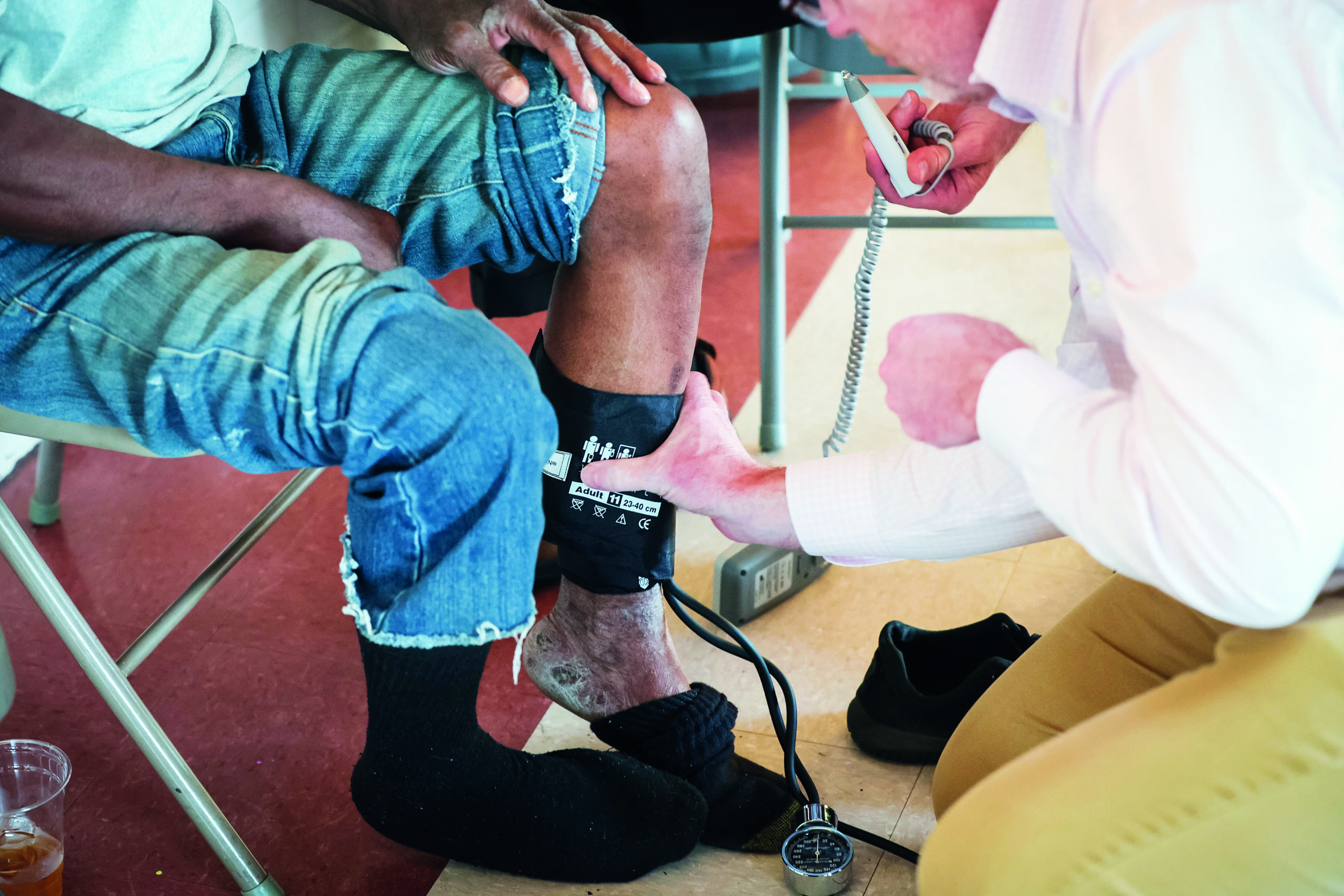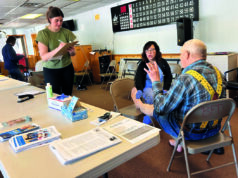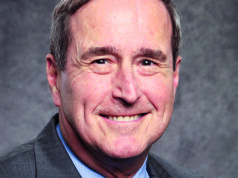
Pioneering American Venous Forum (AVF) and Eastern Vascular Society (EVS) efforts aimed at breaking down barriers to care and educating patients in economically challenged communities on vascular disease have yielded early gains over the first two events staged this year. The vascular surgeons behind these outreach programs—or days of service—tell Vascular Specialist of their plans for the events going forward, an idea they hope catches on among other societies.
“I’m determined to make these work, I’m not giving up. There is something to this.” Kathleen Ozsvath, MD, is observing the scene at a local community center close to the heart of Charleston, South Carolina, where the EVS and AVF are staging a day of service as part of the former’s annual meeting program currently taking place in town.
Foot traffic has been brisk. Local residents are flowing in to hear short presentations on peripheral vascular health, and how both peripheral arterial disease (PAD) and venous insufficiency develop. Key, the talks are being delivered by nurse practitioners in simple, engaging language. Christina Guarin, NP, from the Department of Surgery at the University of Texas Medical Branch (UTMB) in League City, Texas, is in the middle of one, telling assembled members of the public about the signs and symptoms of PAD and how they can spot potential claudication. Across the room, a vascular surgeon and another nurse practitioner are performing ankle-brachial index (ABI) screenings. The remit is simple: reach local communities where they are and build awareness of vascular disease. Ozsvath—one of the chief architects of the event alongside Misaki Kiguchi, MD, the vascular surgery residency program director at MedStar Washington Hospital Center in Washington, D.C.—is energized. “We plan to do this again at the next AVF in February in Atlanta. I think it’s extremely important for societies to give back in this way,” she tells Vascular Specialist. “We teach our trainees, we teach our young surgeons, we teach one another at these academic meetings, but I think it’s also important that we help and reach out to our patients.”
This is the second such community outreach day those involved have organized this year. The first took place during the AVF’s annual gathering, VENOUS 2024, in Tampa, Florida, in March. The group learned much from that initial foray, Ozsvath observes. The first go round, they involved advanced practice providers (APPs) like nurse practitioners, as well as local doctors to ensure familiar points of contact, in addition to industry partners. Learning from that experience, Ozsvath, Kiguchi and company made sure to enlist industry help at an earlier juncture in a bid to increase foot traffic. It worked. “In Tampa, we had people who went out into the street, walked up to people and knocked on doors,” says Ozsvath, looking back a few weeks after the event. “We did the same thing in Charleston, but had a lot more out there. We also asked several local industry reps to put this out there in advance. The local doctors we included also made sure to advertise it to their patients. We were more aggressive—and pointed—in the appropriate directions.”
The initial idea grew out of a societal equity project to perform a day of service with providers, giving them venous disease education so they could try to treat patients in need, explains Kiguchi. The theory goes that, if primary care providers are not up-to-date on what is available for deep vein thrombosis (DVT), superficial venous disease or pulmonary embolism (PE), then what hope is there for disadvantaged patients. “It then evolved into trying to treat people in underserved communities, where we would do a small day of service at the meetings themselves, bringing everyone together,” she says. “It doesn’t necessarily benefit each of us in terms of practice development because we’re coming from out of town, but what we’re trying to do is allow people in the area to understand what venous disease is and to tell them the resources there are in the community to get evaluated.”
Industry involvement proved fruitful. Jobst provided a tranche of compression stockings to be handed out to those who attended, for instance. Some volunteered their time on the night, fanning out into the surrounding community to help draw residents to attend. Scott Dooney, an area vice president with Advanced Oxygen Therapy, Inc., was one. “I think I walked probably two miles in the community,” he recalls. “I talked to anybody. I went solo, and we all wore scrubs. I had interactions with a guy cleaning his car, I went to the playground and talked to a gathering. I handed out the leaflet for the event and explained what we were trying to accomplish. Simply: ‘If you have diabetes in your family, anybody who has had issues with any type of ulcer on their foot—we’re doing a free screening down here at the community center building, we’re going to have some education and there is something to eat. You can also get screened. Bring your significant other and any family members.’”
Other volunteers, including a group led by local vascular surgeon A. Sharee Wright, MD, a clinical associate professor of surgery at Medical University of South Carolina (MUSC), helped corral a family reunion who had gathered in a local restaurant to the event. Current AVF president Ruth Bush, MD, associate dean for educational affairs at the John Sealy School of Medicine at UTMB, was also part of the team on the ground coaxing in passersby, dressed in scrubs like many of her colleagues as a means of gentle greeting.
The sartorial code was deliberate.
“We didn’t want to appear intimidating,” explains Ozsvath. The language used followed suit. Ultimately, the idea was to blend into the community. To not appear formal. “I personally pride myself very much on speaking to people the way I want to be spoken to and try to explain things in a manner people are going to understand,” continues Ozsvath. “When I speak to patients in an office, I speak to them eye-to-eye so I’m not looking down on them. Those are the things that make people feel better and more comfortable.”
Martin Sylvain, a longtime industry leader in the vascular space and consultant, helped co-ordinate industry involvement. He also took part on the day. “The idea was to make it neighborhood-based so people could access the event with ease, walking a block or two to get there, and to provide food and refreshments. If they were to take place at a medical center where people had to take a bus, for example, people might be less likely to attend,” Sylvain says. “It was a great example of industry partnering with vascular surgery to create awareness for vascular disease at the local level.”
Kiguchi looks at the device company participation through a slightly different lens. Ordinarily, their participation at meetings is through traditional sponsorship opportunities like booths, and breakfast and lunch symposia, she notes. “But there is a push to be more involved in community outreach because that is where the patients are. Think about the fact that you’re educating people who are already at the meeting, at these booths, at these lunch meetings, and you’re kind of educating the people who are already educated. So, there is a movement to educate people who really need the education.”
Kiguchi also highlights the importance of community involvement. “One of the main things we realized from Tampa is that the people in these communities we work in don’t plan. So, right before the events begin, we need people out there corralling people in. And we did that. We went around a couple of hours before, into places like Section 8 housing, and invited people along.”
Come VENOUS 2025 in Atlanta (Feb. 16–19)—scene of the next day of service event—Ozsvath and Kiguchi want to piggyback on local community health events. “Reaching out to communities in the church, communities in volunteer programs—not reinventing the wheel but going to these events—is going to increase foot traffic,” Kiguchi says. Eventually, the organizers hope the idea is adopted by other regional and national meetings, hopefully coalescing around a fixed day or weekend on the calendar for vascular surgery outreach, she adds. From the administrative angle, AVF CEO John Forbes, another of the volunteers present at the EVS day of service, observes the scene and marvels at the big step made from version one in Tampa to 2.0 in Charleston. “The longer-term vision is to scale this even bigger, and provide knowledge to the public that is widespread.”
Venous disease education is a particular focus of the outreach. As Ozsvath tells it, “venous disease is underdiagnosed, undertreated, and it is hard enough to teach providers about venous disease, because it is not something we necessarily learn in medical school.” Hence, the need to go directly to the patients, “especially those who may have less access to care,” she adds, and why the host facilities of the events are in underserved areas.
It’s not just venous disease, Kiguchi says: these events also offer an opportunity to focus in on PAD and highlight how the disease process can manifest. Again, the role of nurses in disseminating the information—just as Guarin did alongside Debbie Williams, RN, clinical lead at Vascular Associates in Albany, New York, in Charleston—comes to the fore. “More so now, the first person people are going to see for venous or arterial disease is the nurse practitioner,” Kiguchi reflects. “We really wanted them to be at the forefront. That is something we learned from the AVF in Tampa. There, I did the presentations along with Ruth [Bush] and Kathleen [Ozsvath], but these APPs are fully capable of evaluating these patients on their own. They are more readily available. Us surgeons get called into the operating room, and we have limited time. It makes the most sense that these providers are able to be the ones who evaluate these patients first. So we thought, if these are the folks that these patients are going to see first anyway, then why shouldn’t they be the ones giving the presentations.”
Running in tandem with the effort to give back amid a vascular disease knowledge vacuum is the ever-present issue of vascular surgery’s identity problem. “If you ask the average person, ‘What is a vascular surgeon?’, they don’t know,” says Ozsvath. “Even a lot of physicians will ask, ‘What do you do again? So you must work on the heart.’ These are the things that we, as a group of professionals, have not done a good job of: get out there to explain to people what it is we do.”
Equally as important, Ozsvath argues, is working across specialty boundaries in a similar way to how the outreach effort operates. “This is also about the other specialties we overlap with: interventional radiology, cardiology, cardiothoracic surgery; there are a lot of people in these specialties who do similar work,” she explains. “For patients, that can get confusing. They might think: ‘Do I go to a radiologist to get my veins done, or do I go to a cardiologist? He’s doing my heart; do I go to them for my veins also?’ What really matters is not so much what your specialty is, but whether or not you have the experience and the knowledge to treat a specific disease entity.”
In this climate, collaboration is key, Ozsvath adds, speaking to Vascular Specialist from the vantage point of a cardiac cath lab. “I did eight cases here today. I love working here. They treat me with open arms, and I work really well with the cardiologists. We share patients. I think that goes a lot further with relationships—and also better with our patients. It’s the same thing with the day of service programs. I tell patients all the time: this is a team sport. We’re in this together. It’s your body. You need to be educated so you can make the best decision for you and I’m here to help.”












